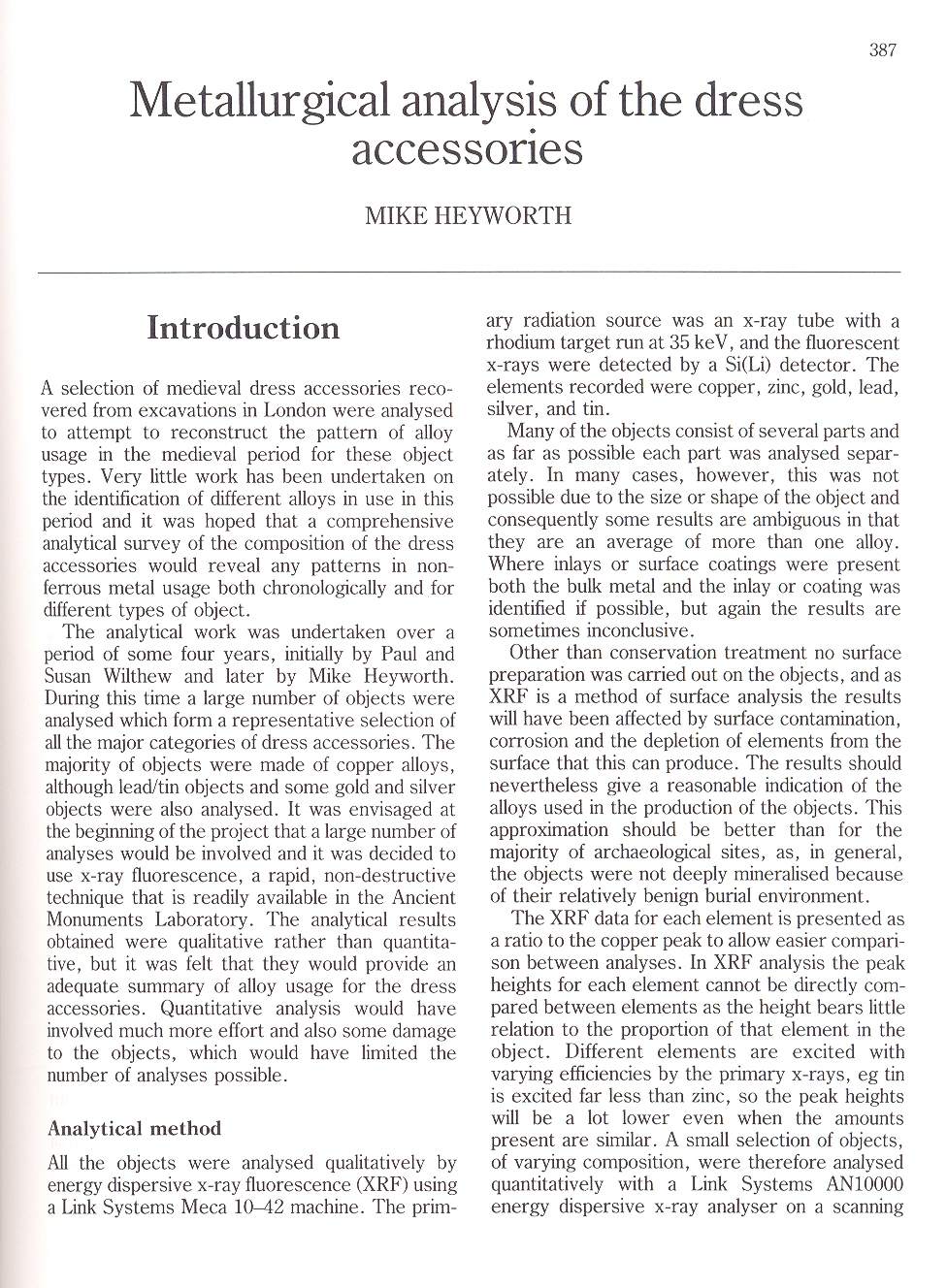414 (12)

387
Metallurgical analysis of the dress accessories
MIKĘ HEYWORTH
Introduction
A sełection of medieval dress accessories reco-vered from excavations in London were analysed to attempt to reconstruct the patiem of alloy usage in the medieval period for these objęci typcs. Very little work has bcen undertaken on the identification of different alloys in use in this period and it was hoped that a comprehensive analytical survey of the composition of the dress accessories would reveal any pattcrns in non-ferrous metal usage both chronologically and for different types of object.
The analytical work was undertaken over a period of some four years, initially by Paul and Susan Wilthew and later by Mikę Heyworth. During this time a large nurnber of objects were analysed which form a representative sełection of all the major categories of dress accessories. The majority of objects were madę of copper alloys, although lead/tin objects and sonie gold and silver objects were also analysed. It was envisaged at the bcginning of the project that a large nurnber of analyses would be involved and it. was decided to use x-ray fluorescence, a rapid, non-deslruclive techniąue that is readily availabłe in the Ancient Monuments Laboratory. The analytical results obtained were qualitative rather than ąuantita-tive, but it was felt that they would provide an adeąuate summary of alloy usage for the dress accessories. Quantitative analysis would have involved much morę elTorl and also some damage to the objects, which would have limited the nurnber of analyses possible.
Analytical melhod
All the objects were analysed qualitatively by energy dispersive x-ray fluorescence (XRF) using a Link Systems Meca 10-42 machinę. The prim-ary radiation source was an x-ray tubę with a rhodium larget run at 35 keV, and the fluorescent x-rays were detected by a Si(Li) detector. The elements recorded were copper, zinc, gold, lead, silver, and tin.
Many of the objects consist of several parts and as far as possible each part was analysed separ-alely. In many cases, however, this was not possible due to the size or shape of the object and consequently some results are ambiguous in that they are an average of morę than one alloy. Where inlays or surface coatings were present both the bulk metal and the inlay or coating w;as identified if possible, but again the results are sometimes inconclusive.
Other than conservation treatment no surface preparation was carried out on the objects, and as XRF is a method of surface analysis the results will have been affected by surface contamination, corrosion and the depletion of elements from the surface that this can produce. The results should neverlheless give a reasonable indication of the alloys used in the production of the objects. This approximation should be better than for the majority of archaeological sites, as, in generał, the objects were not deeply mineralised bccause of their relatively benign burial environment.
The XRF data for each element is presented as a ratio to the copper peak to allow easier compari-son between analyses. In XRF analysis the peak heights for each element cannot be directly com-pared between elements as the height bears little relation to the proportion of that element in the object. Different elements are excited with varying efficiencies by the primary x-rays, eg tin is excited far less than zinc, so the peak heights will be a lot lower even when the amounts present are similar. A smali sełection of objects, of varying composition, were therefore analysed quantilatively with a Link Systems AN10000 energy dispersive x-ray analyser on a scanning
Wyszukiwarka
Podobne podstrony:
420 (12) 393Metallurgical Analysis of the Dress Accessories Lead Lead Fig 266 Copper alloys c. 1270-
12 Grzcbiclcc A,. Analysis of water wapour condcnsation I1R
422 (13) Metallurgical Analysis of the Dress Accessories site form which include a forked spacer san
416 (14) 389Metallurgical Analysis of the Dress Accessories Lead Lead Fig 258 Ali copper alloys. Eac
Summary: The paper presents a financial analysis of the non-profit organization that provides rehabi
00121 ge08f5e71e20195f362e2605eea9911 122 Simpson & Keats by a trade-off analysis in the region
00149 X58e44d67a8fa64ce25678ae9975d0f 150 Simpson & Keats Table 12. Shewhart and CUSUM Control
skanuj0059 (23) 180 MARTA DEREK objectives of the economic development of the commune. For example,
Summary PhD thesis presents analysis of RCM maintenance system implementation for the semi submersib
skanowanie0035 (12) Criteria levels of performance The reąuired level of performance for success sho
skanowanie0107 (2) 12.4.5. Keys to teaching the writing skills A number of things
2013 SYSTEMS SUPPORTING PRODUCTION ENGEINEERING The experiment also focused on analysis of the resul
6 Spis treści Anna Haczkowska, The analysis of difficulties arising during coding an-swers to open-e
108 RIKEN Accel. Próg. Rep. 24 (1990)111-5-12. Status Report of the RIKEN Swinger-Magnetic Analyzer
więcej podobnych podstron